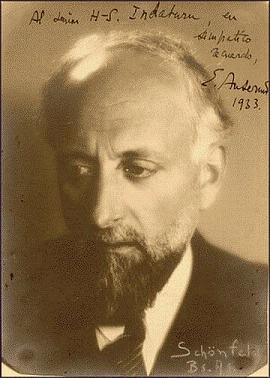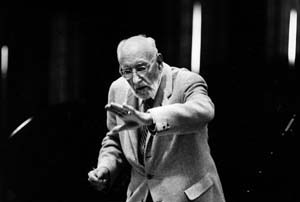Ernest Ansermet facts for kids
Ernest Alexandre Ansermet (born 11 November 1883 – died 20 February 1969) was a famous Swiss conductor. He was known for his clear and precise way of leading orchestras.
Contents
A Life in Music
Ernest Ansermet was born in Vevey, Switzerland. Before becoming a conductor, he was a mathematics professor at the University of Lausanne. He started conducting in 1912 at the Casino in Montreux.
Early Career and Famous Friends
From 1915 to 1923, Ansermet worked as a conductor for Diaghilev's Ballets Russes. This was a very famous ballet company. While traveling in France for this job, he met important composers like Claude Debussy and Maurice Ravel. He often asked them for advice on how to perform their music.
During World War I, Ansermet met Igor Stravinsky, a Russian composer who was living in Switzerland at the time. This meeting began a long friendship and a strong connection between Ansermet and Russian music.
Founding an Orchestra
In 1918, Ansermet started his own orchestra, called the Orchestre de la Suisse Romande (OSR). He traveled widely with his orchestra, performing in many countries in Europe and America. He became well-known for performing difficult modern music very accurately. He even made the first recordings of pieces like Stravinsky's Capriccio, with the composer himself playing the solo part.
Ansermet was also one of the first people in classical music to take jazz seriously. In 1919, he wrote an article praising the jazz musician Sidney Bechet.
International Fame and Recordings
After World War II, Ansermet and his orchestra became very famous around the world. This was thanks to a long contract with Decca Records, a major record company. From that time until he died, he recorded most of the music he performed, sometimes even recording the same piece two or three times.
His performances were seen as very clear and strong. Ansermet preferred to play the original versions of Stravinsky's music, even when Stravinsky himself revised them. He conducted many modern pieces by other composers, such as Arthur Honegger and Frank Martin. However, he did not like the music of Arnold Schoenberg and his followers. Ansermet's views on music and some composers were sometimes very strong and caused controversy.
Stereo Sound Pioneer
In May 1954, Decca made history by recording Ansermet and his orchestra using stereo technology for the first time in Europe. They also recorded the first complete stereo version of The Nutcracker by Tchaikovsky on an LP. Ansermet also conducted early stereo recordings of Debussy's Nocturnes and Prélude à l'après-midi d'un faune.
A part of his recording of The Rite of Spring was used by Decca in 1957 to show off their new stereo sound. In his later years, he recorded works by Haydn, Beethoven, and Brahms.
His very last recording was of Stravinsky's The Firebird. He made this recording in London with the New Philharmonia Orchestra in 1968. He died on 20 February 1969 in Geneva at the age of 85.
Musical Compositions
Ansermet also wrote some of his own music. He composed pieces for piano and orchestra, including a symphonic poem called Feuilles de Printemps (which means 'Leaves of Spring'). In 1939, he also arranged Debussy's Six épigraphes antiques for orchestra.
Important First Performances
Ernest Ansermet helped introduce many new musical works to the world. Here are some of the important pieces he conducted for the very first time:
In Concert
- Stravinsky, Histoire du soldat, in Lausanne, on 28 September 1918.
- Stravinsky, Capriccio for Piano and Orchestra, with the composer playing the piano, on 6 December 1929.
- Stravinsky, Mass, on 27 October 1948.
On Stage
- Manuel de Falla, The Three-Cornered Hat, for the Ballets Russes in Paris, 1919. This was a ballet where Léonide Massine created the dances and Pablo Picasso designed the sets and costumes.
- Stravinsky, Pulcinella, for the Ballets Russes in Paris, on 15 May 1920.
- Prokofiev, Chout, for the Ballets Russes in Paris, 1921.
- Stravinsky, Renard, for the Ballets Russes in Paris, on 18 May 1922.
- Stravinsky, Les noces, for the Ballets Russes in Paris, on 13 June 1923.
On Record
- Stravinsky, Capriccio for Piano and Orchestra, with the composer playing the piano, in May 1930.
Images for kids
-
Ansermet and Wilhelm Kempff in 1965
See also
 In Spanish: Ernest Ansermet para niños
In Spanish: Ernest Ansermet para niños




